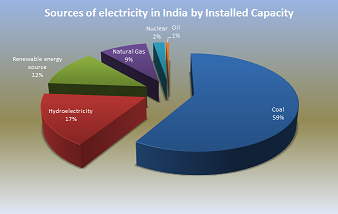Study shows that providing electricity to all of India’s villages will do no harm, says S.Ananthanarayanan.
Official figures say that about 400 million people in India, or about a third of the population, do not have access to electricity. And yet, there is a view that urgency of remedying this condition needs thinking about, on account of the CO2 implications of generating more power for supply to this deprived sector, almost all of which is in rural India.
The journal, Nature Climate Change carries a study by Shonali Pachauri of the International Institute for Applied Systems Analysis (IIASA) in Austria, which soundly debunks this viewpoint, with statistics that show that providing this basic facility of our times to the whole 400 million, the largest number in any country in the world, would have negligible effect on the environment.

“People without electricity are denied the most basic services, from street lighting that can improve safety at night, to mobile phone charging that is vital for communication. Tasks such as milling and grinding cereals that ordinarily require the push of a button can, for the un-electrified, take days of human labour and drudgery, trapping them in subsistence living,” Pachauri says. But looking at the large numbers involved and the urgency to provide not just the bare minimum but also enough to sustain uplift from poverty and economic development, there has been the fear that finding sustainable ways to meet the demand could be challenging.
Current evidence does show that the emission implications would not be significant, but these findings are based on projections, or what is known as ‘prospective assessments’. The work of Pachauri is a departure that comes to the same conclusion on the basis of past data, or a ‘retrospective assessment’. In 2011, household electricity use in India was 20% of total electricity use, and electricity generation contributed 45% of the total CO2 emissions. This was a rise from a 30% share in 1981. During the same period, household electricity access improved from 26% to 67% (or from 25% to 74%, according to the source of the figures). And the share of households connected rose from 19% to 71%, which means 650 million Indian gained access to electricity during these 30 years. The consumers were largely rural and the average electricity use doubled from 400 units per household, a year, in 1981 to over 900 units in 2011. In comparison, the average in 2011 in China is 1,200 units and is more than 10,000 units in the USA.

The data for the study came from two sources, the statistical reports of the Central Electricity Authority and the data collected every five years in the Household Consumer Expenditure Surveys, of the National Sample Survey Organisation. The survey data classifies the consumption by rural or urban and by population sub-groups, which enables further analyses. On the whole, the contribution to CO2 emission of the rural households was about the same as that of urban households, despite the rural sector being two and a half times as large. Within rural and urban groups the poorest households contributed to less than 10% of the rise in emissions, whereas the richest groups contributed about half. Even after considering the indirect increases in emissions, due to better access to other services, that comes from providing access to electricity, the finding is that the effect of 650 million Indians connected since 1981 has led to an increase of 0.008 to 0.018 tonnes of CO2, per person, per year, including transmission and distribution losses. This figure is clearly trivial, compared to the level of 1.6 tonnes annual emission per person, for India in 2011.
Implications
This finding eloquently brushes aside any reasoning based on emissions for delaying access to the deprived 400 million people in India. Also relevant is the rise in use of renewable and non polluting energy sources. India now generates 12% of its electricity from renewable sources and 17% from hydroelectricity. The use of wind and solar energy is rising. Much of rural electrification could be provided for through off-grid and decentralized sources, at further negligible environmental cost.

“Even if it is conservatively assumed that the carbon intensity of electricity production remains unchanged from its present level, and rural electricity demand grows aggressively over the next two decades as a consequence of new applications of electricity (for example, information and communication technologies) and/or quicker diffusion of new appliances (for example, electric induction stoves), the newly electrified in India are unlikely to contribute significantly to global or even national emissions growth,” Pachauri says.
“In the short-term, ending poverty should be an overriding priority for developing countries. Given the present abysmally low levels of average energy use in rural and poor households, electricity demand can be expected to rise—and, indeed, must to raise living standards,” Pachauri says. “India is at a similar stage to many other developing countries in terms of energy access… So we believe that these findings will be applicable on a broad scale to other developing countries," she says.
Do respond to : response@simplescience.in
------------------------------------------------------------------------------------------